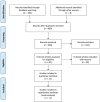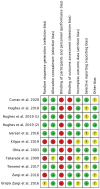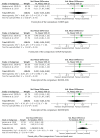The Effects of Blood Flow Restriction in Patients Undergoing Knee Surgery: A Systematic Review and Meta-analysis
- PMID: 34406084
- PMCID: PMC9354069
- DOI: 10.1177/03635465211027296
The Effects of Blood Flow Restriction in Patients Undergoing Knee Surgery: A Systematic Review and Meta-analysis
Abstract
Background: Blood flow restriction (BFR) training has been shown to have beneficial effects in reducing quadriceps muscle atrophy and improving strength in patients with various knee pathologies. Furthermore, the effectiveness of BFR training in patients undergoing knee surgery has been investigated to determine if its use can improve clinical outcomes.
Purpose/hypothesis: The purpose of this study was to conduct a systematic review and meta-analysis to examine the effectiveness of BFR training in patients undergoing knee surgery. We hypothesized that BFR, before or after surgery, would improve clinical outcomes as well as muscle strength and volume.
Study design: Systematic review and meta-analysis; Level of evidence, 4.
Methods: This systematic review and meta-analysis of peer-reviewed literature was conducted using PubMed, Embase, and Cochrane databases from 1980 to present. Search results were limited to those assessing BFR training in patients undergoing knee surgery published in a scientific peer-reviewed journal in English. Selected studies subsequently underwent data extraction, methodological quality assessment, and data analysis.
Results: Eleven studies were eligible, including anterior cruciate ligament reconstruction (n = 10) and knee arthroscopy (n = 1). Two studies specifically assessed BFR use in the preoperative time frame. For the meta-analysis, including 4 studies, the primary outcome variables included the cross-sectional area of the quadratus femoris muscle group assessed with magnetic resonance imaging or ultrasonography, and patient-reported outcome measure scores. The results demonstrated that BFR use in the postoperative time period can lead to a significant improvement in the cross-sectional area when quantifying muscle atrophy. However, there were no significant differences found for patient-reported outcome measures between the included studies. It should be noted that 4 of the included papers in this review reported increases in clinical strength when using BFR in the postoperative setting. Last, preoperative BFR training did not show any significant clinical benefit between the 2 studies.
Conclusion: This is the first systematic review and meta-analysis to study the effects of BFR in patients undergoing knee surgery. The results of this analysis show that BFR in the postoperative period after knee surgery can improve quadriceps muscle bulk compared with a control group. However, future research should examine the effects of preconditioning with BFR before surgery. Lastly, BFR protocols need to be further investigated to determine which provide the best patient outcomes. This will help standardize this type of treatment modality for future studies.
Keywords: blood flow restriction training; knee; muscle atrophy; quadriceps strengthening; surgery.
Conflict of interest statement
The authors declared that they have no conflicts of interest in the authorship and publication of this contribution. AOSSM checks author disclosures against the Open Payments Database (OPD). AOSSM has not conducted an independent investigation on the OPD and disclaims any liability or responsibility relating thereto.
Figures
References
-
- Blackburn JT, Pietrosimone B, Harkey MS, Luc BA, Pamukoff DN. Quadriceps function and gait kinetics after anterior cruciate ligament reconstruction. Med Sci Sports Exerc. 2016;48(9):1664-1670. - PubMed
-
- Curran MT, Bedi A, Mendias CL, et al.. Blood flow restriction training applied with high-intensity exercise does not improve quadriceps muscle function after anterior cruciate ligament reconstruction: a randomized controlled trial. Am J Sports Med. 2020;48(4):825-837. - PubMed
-
- Daniel DM, Lumkong G, Stone ML, Pedowitz RA. Effects of tourniquet use in anterior cruciate ligament reconstruction. Arthroscopy. 1995;11(3):307-311. - PubMed
Publication types
MeSH terms
LinkOut - more resources
Full Text Sources
Medical




